Injuries to tendons can be tricky to heal, but with early detection and the right treatment, the outcome can be significantly improved, as vet Laura Quiney, from the Animal Health Trust, explains
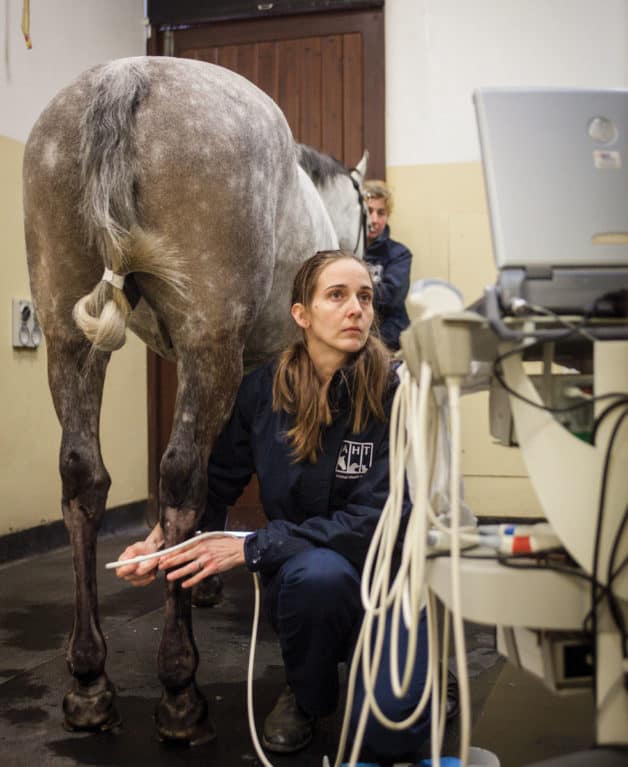
When your vet diagnoses a tendon injury, it’s never welcome news. It could mean a long period of time off work and an increased risk of reinjury and, in severe cases, may be career-ending. Unfortunately, a tendon injury can affect any horse, but arming yourself with the knowledge of how tendons work and can be damaged will help you to manage injuries and take steps to prevent them, too. Plus, knowing what signs of injury to look for will help you spot problems early so they can be treated promptly, increasing your horse’s chances of a good recovery.
What is a tendon?
Tendons are strong bands of tissue that connect muscles to bones and transmit the forces generated by a contracting muscle to the skeletal system, which results in movement. They’re made of long strands of collagen that are organised into parallel bundles. This gives them their high tensile strength, which means that they’re able to resist great pulling forces, and they’re also slightly elastic.
Breaking point
Tendons have a limited capacity for coping with strain. Beyond that point, they can’t continue to stretch elastically and the fibres are damaged. Interestingly, in a galloping horse, the strain experienced by the superficial digital flexor tendon is very close to the strain at which fibre damage can occur. This is why tendons are said to have a small safety margin.
Tendons of the lower leg
Your horse’s body is full of tendons, but the most important ones are in his lower legs. They’re named according to what they do…
- the extensor tendon runs down the front of your horse’s leg and extends (straightens) it
- the flexor tendons run down the back of your horse’s legs and flex (bend) it. There are two – the superficial digital flexor tendon and the deep digital flexor tendon. They’re easy to feel at the very back of your horse’s lower leg, with the superficial digital flexor tendon the furthest back, just underneath the skin.
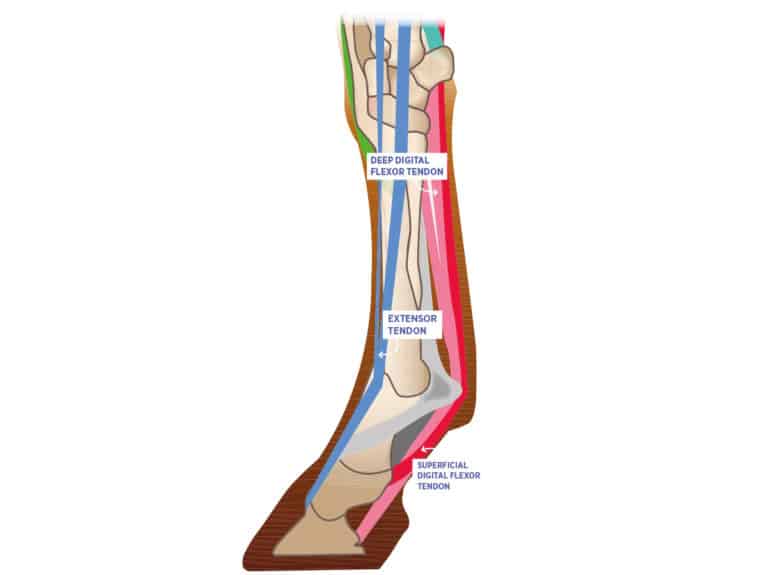
The superficial digital flexor tendon divides into two branches at the pastern, and crosses either side of the deep digital flexor tendon to attach onto the back of the long and short pastern bones. The deep digital flexor tendon continues further down into the hoof, passing over the back of the navicular bone and attaching to the pedal bone. Both flexor tendons have their own check ligament, which anchors the back of each tendon to the underlying bone, preventing them from overstretching.
Did you know?
It’s unusual for a single traumatic event to result in serious tendon injury. Usually, it’s repetitive, low-grade overload causing mild damage that leads to major injuries.
Superficial digital flexor tendon injury
The most common tendon to be injured is the superficial digital flexor tendon, usually in the cannon region. While galloping, the fetlock joint sinks significantly, which is when the strain through this tendon is greatest. This perhaps explains why injury to the superficial digital flexor tendon is most common in racehorses and event horses.
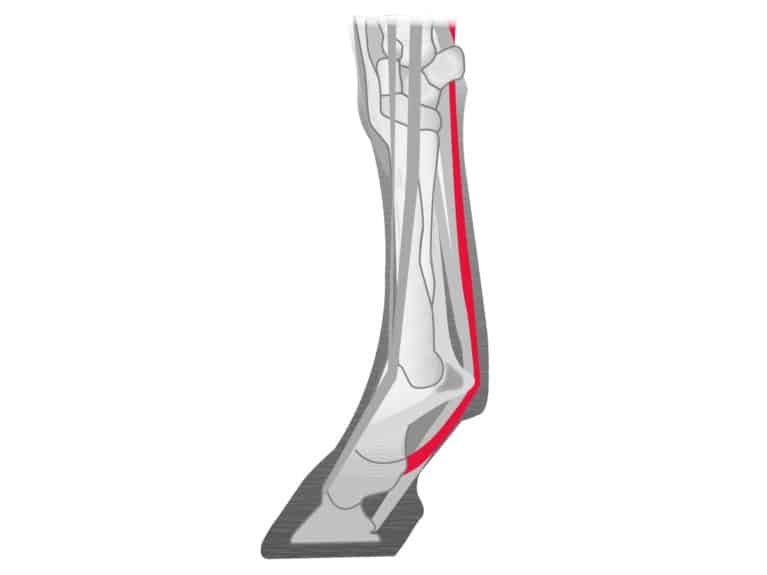
Landing after a jump also puts huge strain through this tendon in the forelegs and the higher the jump, the greater the strain. Therefore, top showjumpers are at increased risk and it’s an additional risk factor for eventers, too. Injuries like this are occasionally seen in horses who specialise in dressage, but are rare in leisure horses, except older ones, who are at greater risk due to age-related degenerative changes to the tendon.
Signs
The signs of superficial digital flexor tendon injury usually include…
- lameness, although the severity can vary and horses sometimes come sound after 1–2 days. Some horses remain sound, even with a significant injury
- swelling of the tendon, which is usually easy to see because it sits just under the skin at the back of the leg. The swelling can change the profile of the back of the
leg, giving it the classic bowed appearance, but it can also be subtle, so it’s important to feel your horse’s leg in both a weight-bearing and flexed position - heat around the site of injury
- pain when the area is felt
- dropped fetlock. This occurs if there’s a full thickness rupture because the tendon goes floppy and is unable to support the joint. This is usually the result of external trauma, such as a laceration, rather than workload
Top tip
If a horse with a mild injury, who had minimal or short-lived signs, continues to be exercised when the symptoms disappear, there’s a danger the damage may become more extensive and difficult to treat. So always be cautious if you suspect a tendon injury.
Diagnosis
An ultrasound scan is essential for assessing how much damage there is, and for deciding how best to treat and manage the injury. It can also give an idea of how likely your horse is to return to full work and how long that will take. He may need more scans to monitor how the injury’s healing and its response to treatment, and to determine when it’s appropriate to increase his exercise without risking damage to the healing tendon.
Treatment
Initially, the aim of treatment is to control the inflammation. While it’s important to start the healing process, inflammation can cause further tissue damage and aggravate the injury. After that, the aim is to encourage healing of the tendon. It’s important to encourage normal tendon tissue to develop rather than scar tissue, which is less elastic and, therefore, increases the likelihood of reinjury. Your vet is likely to prescribe…
- anti-inflammatory therapy, such as non-steroidal anti-inflammatory drugs (NSAIDs), and cold therapy, such as cold-hosing the area, which are most important in the week following injury, when the inflammatory response is greatest
- firm pressure bandaging, which is important to control swelling, but must be applied correctly
- strict exercise management, which is vitally important for healing. Horses who are turned out tend not to recover as well as horses who are kept on box rest. While on box rest, an increasing, controlled walking programme is essential to stimulate the parallel alignment of collagen fibres in the tendon, which is important for strength
- regenerative therapy, such as stem cell therapy and platelet-rich products. These aim to enhance healing and promote the development of normal tendon tissue rather than scar tissue. Some studies have shown that stem cell therapy for superficial digital flexor tendon injuries results in decreased reinjury rates. However, the response to stem cell therapy is variable
Prognosis
The prognosis for this type of injury depends on how severe it is and what level of work the horse will be expected to do – generally, the more damage there is, the worse the chances of recovery. The speed of healing varies, but most horses need about a year to recover.
Deep digital flexor tendon injury in the foot
Injury to the end of the deep digital flexor tendon can occur in the forelegs, within the hoof capsule. Showjumpers, especially those working at higher levels, appear to be more susceptible. It’s thought that horses with poor hoof balance, particularly a long toe and low heel (broken back hoof-pastern axis) are more prone to deep digital flexor tendon injuries due to the excess stress this puts on the tendon. About 15% of horses with a deep digital flexor tendon lesion have long toes and low heels, however this association isn’t supported by current research.
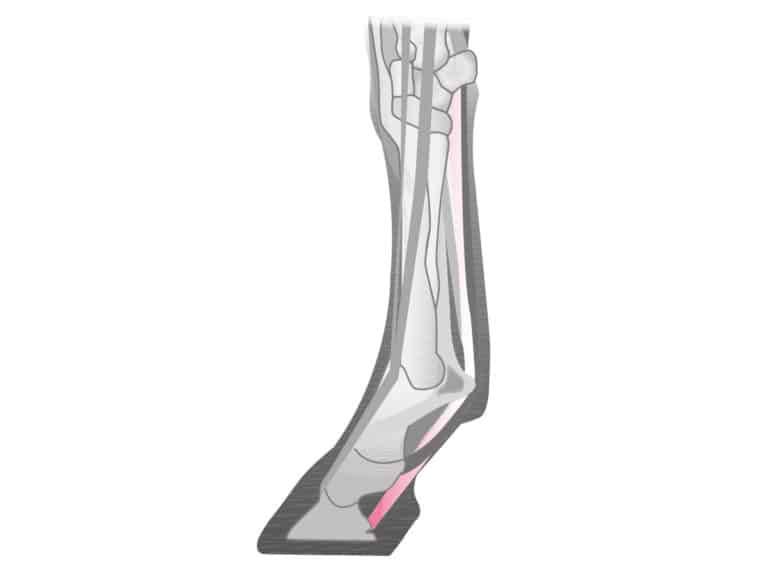
Signs
Lameness in the affected limb.
Diagnosis
Nerve blocks can narrow down the source of pain to the foot, however an injury of the deep digital flexor tendon won’t show up on X-ray and it’s impossible to see all of the tendon within the foot using ultrasound. Magnetic resonance imaging (MRI) is often the only way to diagnose this injury.
Treatment
Treatment usually involves prolonged rest. This can vary from 2–8 months, but some horses need substantially longer. Keyhole surgery (bursoscopy) can be performed on some surface tears at the level of the navicular bursa, which is a fluid-filled pouch between the deep digital flexor tendon and the navicular bone. This involves inserting a small camera and surgical tools into the navicular bursa to access the deep digital flexor tendon and remove torn fibres.
Prognosis
The prognosis for return to ridden work is generally poor. If surgery is an option for the injury, it’s more likely that the lameness will improve, although not all horses are able to return to the same level of ridden work and of those who do, a proportion relapse.
Deep digital flexor tendon injury in the pastern and fetlock region
This is another common site of tendon injury and here the deep digital flexor tendon is surrounded by a fluid-filled pouch called the digital flexor tendon sheath.
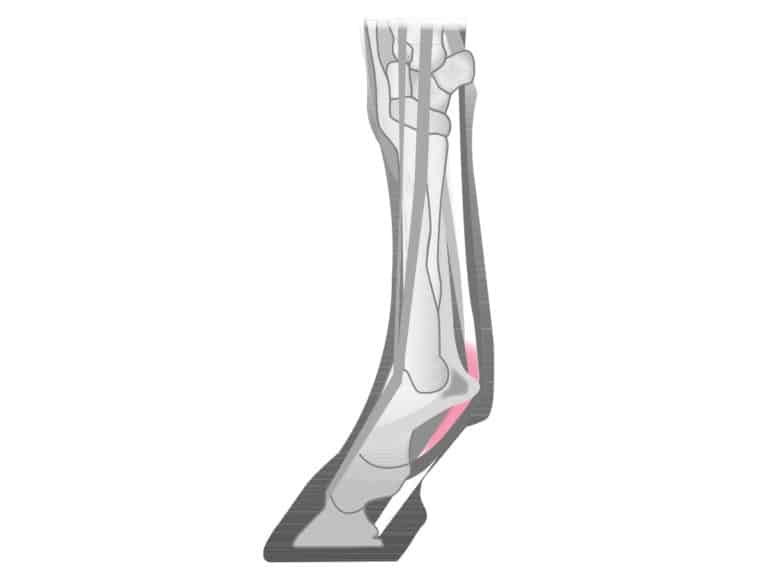
Signs
Signs of deep digital flexor tendon injury usually include…
- lameness
- pain when the area is felt
- heat at the site of injury
- swelling of the tendon
- development of windgalls due to excess fluid, if the injury is within the digital flexor tendon sheath
Treatment
Small core lesions (holes inside the tendon) can be managed in a similar way to superficial digital flexor tendon injuries. Large core lesions tend not to do so well with this type of management, but the injection of stem cells can improve the outcome in some horses. Lesions involving the outer surface of the tendon, such as a split, can be surgically treated to remove the torn fibres.
Diagnosis
Ultrasound examination is very useful to diagnose this type of injury although for some tears, such as those at the edges of the deep digital flexor tendon, MRI is more effective. If a lesion is strongly suspected despite a clear ultrasound scan, then keyhole surgery (tenoscopy) to look at the tendon and, if necessary, remove the torn fibres is often a more cost-effective option than MRI.
Prognosis
The prognosis, even for young horses, is relatively poor, with only about 40% returning to full work.
Digital extensor tendon injury
The common digital extensor tendon is much less prone to injury than the flexor tendons. Injury most frequently occurs as a result of external trauma and is most likely to affect a hindlimb.
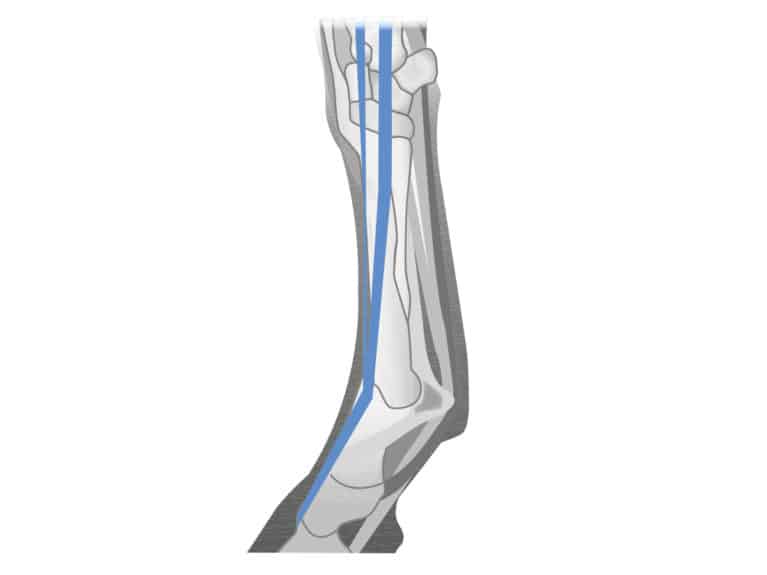
Signs
If the tendon ruptures or is fully severed, then your horse won’t be able to extend his toe and may trip or knuckle over. Horses usually adapt their way of moving by flicking their foot forward in an exaggerated manner.
Treatment
Because this injury is caused by damage to the leg the associated wound will need treating, but otherwise the injured tendon rarely needs specific treatment. The horse will need box rest with in-hand walking while he recovers. It’s important that he’s walked carefully at first while he learns how to walk without tripping. It’s sensible to bandage the legs to prevent injury to the fetlock and foot if he does trip or knuckle over.
Diagnosis
Signs of trauma to the front of the leg, along with tripping or exaggerated toe flicking, are normally enough to make a diagnosis.
Prognosis
The prognosis for return to work is usually good.
Keep a close eye
Promptly identifying mild injuries will reduce the chance of a major injury. It’s really important to check your horse’s legs regularly for heat, swelling and pain, and to react quickly to any sign of injury. If you suspect your horse has damaged a tendon, cold hose the area immediately and call your vet.
It’s sensible to use cold therapy routinely after strenuous exercise to reduce blood flow and dissipate heat, because after exercise inflammatory mediators and free radicals will be released, which can cause tissue damage. However, using cold therapy after exercise could disguise pain, heat and swelling, so it increases the chance of missing the signs of an injury. Therefore, it’s important to closely monitor your horse’s legs after hard work.
Your Comments
One thought on “Tackling tendon injuries”
Leave a Reply
You must be logged in to post a comment.






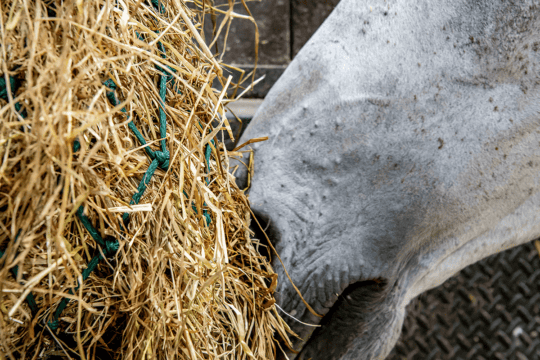





I think my racehorse has an injury to his Digital extension tendon ~ right front. He shows a pain reaction when the ankle is flexed and is slightly lame for a few days after a race. He is sensitive to palpating at the cannon bone right above his ankle But little heat or swelling in ankle. X rays negative. Hard to have ultrasound done .Can this injury heal on its own ?